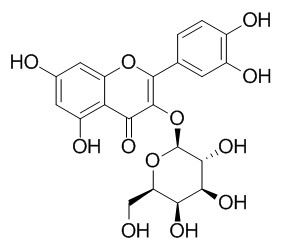Natural Products
Hyperoside
| Catalog No. | CFN98754 |  |
| CAS No. | 482-36-0 | |
| Molecular Weight: | 464.4 | |
| Molecular Formula | C21H20O12 | |
| DBs | [PubChem]:274951750 [ChEMBL]: [PCIDB]:5372 |
Standard InChI:
InChI=1S/C21H20O12/c22-6-13-15(27)17(29)18(30)21(32-13)33-20-16(28)14-11(26)4-8(23)5-12(14)31-19(20)7-1-2-9(24)10(25)3-7/h1-5,13,15,17-18,21-27,29-30H,6H2/t13-,15+,17?,18?,21+/m1/s1
Biological Activity
Hyperoside, a flavonoid glycoside isolated from Artemisia capillaris, has protective effects against CCl4-induced acute liver injury, and this protection is likely due to enhancement of the antioxidative defense system and suppression of the inflammatory response.[1]
Hyperoside can protect Aβ-induced primary cultured cortical neurons via PI3K/Akt/Bad/Bcl XL -regulated mitochondrial apoptotic pathway, and they raise the possibility that hyperoside could be developed into a clinically valuable treatment for Alzheimer's disease and other neuronal degenerative diseases associated with mitochondrial dysfunction.[2]
Hyperoside is a strong inhibitor of HBsAg and HBeAgsecretion in 2.2.15 cells and DHBV-DNA levels in the HBV-infected duck model.[3]
Hyperoside isolated from Camptotheca acuminata, has antifungal activity, may serve as leads for the development of fungicides.[4]
Hyperoside has cytoprotective effects against hydrogen peroxide (H2O2)-induced cell damage by scavenging intracellular ROS and enhancing antioxidant enzyme activity, and protects HUVECs against H(2)O(2) damage, at least partially, by activating the ERK signaling pathway. [5,6]
Hyperoside has a variety of pharmacological effects including anti-viral, anti-oxidative, and anti-apoptotic activities and it has anti-Inflammatory activity through the suppression of nuclear factor-κB activation in mouse peritoneal macrophages.[7]
Product
References
[1] Choi J H, Kim D W, Yun N, et al. J Nat Prod, 2011, 74(5):1055-60.
[2] Zeng K W, Wang X M, Ko H, et al. Eur J Pharmacol, 2011, 672(1-3):45-55.
[3] WU, Lin‐lin, YANG, Xin‐bo, HUANG, Zheng‐ming, et al. Acta Pharmacol Sin, 2007, 28(3):404-9.
[4] Li S, Zhang Z, Cain A, et al. J Agrl Food Chem, 2005, 53(1):32-7.
[5] Mei J P, Kang K A, Rui Z, et al. BBA- Biomembranes , 2008, 1780(12):1448-57.
[6] Li Z L, Liu J C, Hu J, et al. J Ethnopharmacol, 2012, 139(139):388-94.
[7] SuJin Kim, JaeYoung Um, SeungHeon Hong, et al. Am J Chinese Med, 2012, 39(1):171-81.
[8] Zhou C L, Sun L L, Kai-Shun B I. Chinese J Pharm Analysis, 2009, 25(15):6760-71.
Product Use Citation





